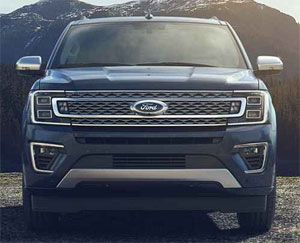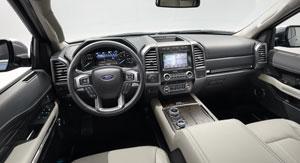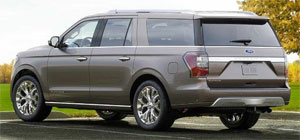2018 Ford Expedition
With the reborn Explorer and a host of other uni-body crossovers in their lineup, it’s easy to forget that Ford still make a big body-on-frame SUV…the Expedition. It’s been around for three generations now, and an all-new fourth gen Expedition delivers the biggest change yet, joining the F150 with an all-aluminum body. So, let’s see if lighter is righter.
Even in a utility world gone crossover, there are still plenty of people that need a big, truck-based SUV like this 2018 Ford Expedition. But, we’ve covered all of that before. So, what improvements does this all-new Expedition offer the power-hungry, trailer-towing, family-hauling utility buyer?
Well for starters, not only is styling more modern; but like the F150 it shares its basic full frame design with, body panels are now made of aluminum. That helps to shave off about 300-lbs. of weight.
But rather than with the F-150, the face of the full-size Expedition is more akin to the mid-size Explorer; while body sides are not quite as rounded as before, with a less obvious greenhouse. Indeed, from a distance, it appears very similar to its biggest competitor, the segment dominating Chevrolet Tahoe.
 Expedition wheelbase is 122.5-inches, about 3½ more than before. And yes, a longer wheelbase Suburban fighter is available as well, at 131.6-inches, now known as the Expedition MAX.
Expedition wheelbase is 122.5-inches, about 3½ more than before. And yes, a longer wheelbase Suburban fighter is available as well, at 131.6-inches, now known as the Expedition MAX.
Cargo capacity is up; now 20.9 cubic-ft. behind the standard 3rd row, 63.6 behind the 2nd, and 104.6 with all seats folded. Perfect for late night Walmart runs. 7 or 8 passenger seating is available, with 2nd row getting a new tip-and-slide function.
Thanks to the longer wheelbase, space is more plentiful all around, beating Tahoe in second row legroom by over 2 1/2 inches. There are ample options for plugging in, and you can even live stream satellite or cable TV to the entertainment system.
Platinum trim is tops for now, with materials fitting the name. But the bulk of volume will be made up by mid-level Limited; which includes a power folding 3rd row, heated seats for 1st and 2nd rows, as well as a heated steering wheel.
Gauges are very similar to the F150’s with a mix of analog with virtual gauges, along with a wide, configurable TFT display.
Expedition power still comes from a 3.5-liter V6 EcoBoost twin-turbo. But, it’s the F150’s latest variants. Standard output is 375 horsepower, a gain of 10, with 470 lb-ft of torque. Our Platinum trimmed beast however gains 35 horses to 400 even, with torque at 480.
 Attached, is Ford and GM’s joint venture 10-speed automatic transmission; which allows for better power at launch, as well as lower cruising RPM on the high end, for improved efficiency. It’s one of the best modern automatics we’ve sampled; finding the right gear quickly without searching around like most rival’s 9-speeds we’ve driven.
Attached, is Ford and GM’s joint venture 10-speed automatic transmission; which allows for better power at launch, as well as lower cruising RPM on the high end, for improved efficiency. It’s one of the best modern automatics we’ve sampled; finding the right gear quickly without searching around like most rival’s 9-speeds we’ve driven.
Maximum towing capacity is 9,300-lbs., significantly more than the Tahoe’s 8,600; and by far best-in-class. The F150’s Pro Trailer Backup Assist is available as well.
The optional 4-wheel drive system comes with an updated version of Ford’s Terrain management system with up to 7-different drive modes, for helping you through just about any situation you may find yourself in.
There’s also an available FX4 Off-Road Package. And while it isn’t quite Raptor-spec, you do get an automatic limited-slip rear, off road shocks, 7-skid plates, and 18-inch wheels with A/Ts, for when you leave the trailer behind and venture further off the beaten path.
The independent front suspension is virtually identical to the F150’s, while in back there’s an updated version of the outgoing Expedition’s multi-link setup rather than a solid axle.
 Ford has gone to great lengths to quiet the interior down, and it is indeed very calm inside; and without a doubt, road manners have improved greatly thanks to continuously controlled damping. But despite the weight loss and myriad of updates, it’s still hard to disguise the fact that this is a very big truck-like vehicle, and continues to ride and drive like a one.
Ford has gone to great lengths to quiet the interior down, and it is indeed very calm inside; and without a doubt, road manners have improved greatly thanks to continuously controlled damping. But despite the weight loss and myriad of updates, it’s still hard to disguise the fact that this is a very big truck-like vehicle, and continues to ride and drive like a one.
And while there are certainly a few people out there that prefer that in their utility; the fact that very few body-on-frame SUVs remain, while crossovers have taken over the segment, would suggest that the majority of people don’t.
Thanks to that 10-speed automatic, Government Fuel Economy Ratings for a 4X4 Expedition are 17-City, 22-Highway, and 19-Combined; that’s up from 17-Combined last year. It still has a poor Energy Impact Score though, at 17.3-barrels of annual oil consumption with CO2 emissions of 7.7-tons.
There’s no way around it, you’ve got to pay to play in this segment. Pricing starts at $52,890. Adding 4-wheel-drive varies with trim level, but adds about $3,000 more. So, you’re looking at around $75,000 for top Platinum trim, even more if you opt for the Lincoln Navigator variants.
So for 2018, the highly-evolved Ford Expedition improves in every possible way; whether you’re talking capability, interior space, fuel economy, and certainly style. Ford fans will love what they see, and no doubt this Expedition will create a few more fanatics for the brand as well.
Specifications
- Engine: 3.5 liter
- Horsepower: 400
- Torque: 480 lb-ft.
- EPA: 17 mpg city / 22 mpg highway
- Energy Impact: 17.3 barrels of oil/yr
- CO2 Emissions: 7.7 tons/yr
2025 Volkswagen ID. Buzz
Volkswagen Brings Beetlemania Level Of Excitement To Minivan Segment
The duty of upholding Volkswagen’s heritage has most recently been delegated to small legacy car names like Golf and Jetta. But hold on! A much larger, totally modern take on VW’s classic microbus has just buzzed over the horizon— the all-electric ID. Buzz. It’s been at the top of our minds since we first saw the concept back in 2017. Well, it’s finally here, so let’s get our groove into drive!
This 2025 Volkswagen ID. Buzz has indeed created the most buzz around Volkswagen since the Beetle’s return to the U.S. in the late 1990s. We couldn’t drive it anywhere without drawing a crowd. No wonder, just about everyone has a VW Microbus story to tell, and seeing this reimagined version rolling down the street brings back all those memories.
VW really pulled it off as far as we’re concerned, as it looks great without appearing over the top. All the cues are here: Big VW logo front and center, lots of greenhouse including A-pillar windows and mini sliders for the second-row passengers, D-pillar air vents, and two-tone wheels. And while its appearance may be pure retro, its drivetrain is far from it, as the ID. Buzz is all-electric, and unlike the new Beetle, the Buzz does retain the original Microbus’ rear-drive architecture.
Powering those rear wheels is a 210-kW motor drawing juice from a 91-kWh battery for a range of 234 miles; 200-kW max charging will get you to 80% in about 26 minutes. Buyers can add another small 80-kW motor up front for 4motion all-wheel-drive and an increase of total output from 282 to 335 horsepower with a combined 512 lb-ft of torque. It uses the same battery, but range estimates drop just slightly to 231 miles. But while those numbers are modest, we also found them to be quite conservative, as we observed as many as 287 miles available in our all-wheel-drive tester’s gauge display and were on pace for 273 miles in our driving loop.
One throwback theme that may be a turnoff to some is that it’s quite a step up into the Buzz’s front seats, but there’s certainly a commanding view of the road once you climb in. Second row seating can be either a three-place bench or a pair of captain’s chairs, so there’s generous room for seven or six passengers. The captain’s chairs in our Pro S Plus offer good support and very easy access to the third row.
Lots of flexibility too with the option to simply fold the seats or remove them altogether.
With the sliding side doors and a wide opening rear hatch, there’s plenty of access for loading big sport utility amounts of cargo. Lots of flexibility too with the option to simply fold the seats or remove them altogether, and the ability to create a full-length flat floor with a rear cargo shelf that covers some handy removable storage bins. There’s 18.6 cubic-feet of space behind the third row, 75.5 behind the second, and a max of 145.5. That’s more than a Chevrolet Tahoe. For smaller items, there are lots of cubbies throughout the cabin, along with a standard Buzz Box that can be moved to multiple locations.
With a design that prioritizes retro form and modern function over aero efficiency, the 4motion equipped ID. Buzz earns a Fair efficiency rating, using 42-kWh of electricity per 100 miles, and we weren’t sure what to expect at our Mason Dixon test track.
What we found was great torque off the line and drama free launches to 60 in just 5.3 seconds. It was very stable at speed and power delivery stayed steady most of the way down the track until we reached about 90 mph, when it began to taper off just before we finished the quarter-mile in 14.0 seconds flat at 97 mph.
With 1,200-lbs. of battery weight nestled in its 127.5-inch wheelbase, the Buzz felt planted to the pavement through our handling course. There was quite a bit of body roll to deal with, but surprisingly little understeer. In panic braking runs, pedal response was inconsistent, feeling soft at times, pushing back hard at others; but through it all, results were quite good, stopping from 60 in an average of just 108 feet.
Three interior themes are available, this Dune is the brightest, featuring coastal inspired wood optic dash décor, “gray and clay” leatherette surfaces, and a high-mounted central 12.9-inch touchscreen. Pricing starts with a rear-wheel-drive Pro S at $61,545; this Pro S Plus begins at $65,045, add another $4,500 for 4motion, which brings a few extra features along with all-wheel drive.
Retro design with old-school VW charm, modern EV drivetrain, big SUV capacity merged with minivan flexibility; it all comes together in this 2025 Volkswagen ID. Buzz. It’s easily one of the coolest rides of the year and one that will likely keep Volkswagen dealers buzzing for years to come, and that’s something no other people and things mover can say.
Specifications
As Tested
- Motor Setup: Dual-Motor AWD
- Battery Size: 91-kWh
- Horsepower: 335
- Torque: 512 lb-ft
- EPA Range: 231 miles
- 0-60 mph: 5.3 seconds
- 1/4 Mile: 14.0 seconds at 97 mph
- Braking, 60-0: 108 feet
- MW Test Loop: ~ 273 miles













































